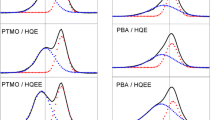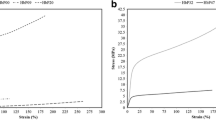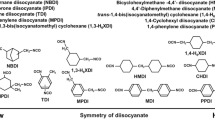Abstract
Two series of segmented thermoplastic polyurethanes were synthesized having 33 wt % hard segment based on 4,4′-dicyclohexyl methane diisocyanate with different trans–trans isomer contents and 1,3-propanediol chain extender. The soft segments were based on poly(hexamethylene–pentamethylene carbonate)diol and poly(butylene sebacate)diol, amorphous and semicrystalline polyol, respectively. 4,4′-Dicyclohexyl methane diisocyanate with different trans–trans isomer contents were obtained by fractional crystallization of commercial diisocyanate and were characterized by differential scanning calorimetry and nuclear magnetic resonance spectroscopy. 4,4′-Dicyclohexyl methane diisocyanate trans–trans isomer lead to some interesting properties in the synthesized polyurethanes, due to the more ordered hard domains formed by packing of trans–trans 4,4′-dicyclohexyl methane diisocyanate. Thereby, as 4,4′-dicyclohexyl methane diisocyanate trans–trans isomer content increased, a better phase separated structure was observed.










Similar content being viewed by others
References
Król P (2007) Synthesis methods, chemical structures and phase structures of linear polyurethanes. Properties and applications of linear polyurethanes in polyurethane elastomers, copolymers and ionomers. Prog Mater Sci 52:915–1015. doi:10.1016/j.pmatsci.2006.11.001
Meier-Westhues U (2007) Polyurethanes: coatings, adhesives and sealants. Vincentz Network GmbH & Co KG, Hannover
Thomson T (2004) Polyurethanes as specialty chemicals. Principles and applications. CRC Press, West Newbury, MA
Randall D, Lee S (2003) The polyurethanes book. Wiley, London
Fernández-d’Arlas B, Ramos JA, Saralegi A, Corcuera M, Mondragon I, Eceiza A (2012) Molecular engineering of elastic and strong supertough polyurethanes. Macromolecules 45:3436–3443. doi:10.1021/ma300397e
Macocinschi D, Filip D, Vlad S, Cristea M, Butnaru M (2009) Segmented biopolyurethanes for medical applications. J Mater Sci Mater Med 20:1659–1668. doi:10.1007/s10856-009-3731-3
Fong N, Simmons A, Poole-Warren L (2011) Elastomeric nanocomposites for biomedical applications. Recent Adv Elast Nanocompos 9:255–278. doi:10.1007/978-3-642-15787-5_10
Guelcher SA (2008) Biodegradable polyurethanes: synthesis and applications in regenerative medicine. Tissue Eng Part B Prev 14:3–17. doi:10.1089/teb.2007.0133
McDevitt TC, Woodhouse KA, Hauschka SD, Murry CE, Stayton PS (2003) Spatially organized layers of cardiomyocytes on biodegradable polyurethane films for myocardial repair. J Biomed Mater Res A 66:586–595. doi:10.1002/jbm.a.10504
Grad S, Kupcsik L, Gorna K, Gogolewski S, Alini M (2003) The use of biodegradable polyurethane scaffolds for cartilage tissue engineering: potential and limitations. Biomaterials 24:5163–5171. doi:10.1016/S0142-9612(03)00462-9
Vermette P, Griesser HJ, Laroche G, Guidoin R (2001) Biomedical applications of polyurethanes (Tissue Engineering Intelligence Unit). Landes Bioscience, Austin, TX
Macocinschi D, Filip D, Vlad S (2010) Surface and mechanical properties of some new biopolyurethane composites. Polym Compos 31:1956–1964. doi:10.1002/pc.20994
Lee DK, Tsai HB, Standford JL (1996) Phase separation and phase inversion of polyurethane networks. J Polym Res 3:159–163. doi:10.1007/BF01494525
Sriram V, Radhakrishnan G (2005) Novel short-chain crosslinked cationomeric polyurethanes. Polym Bull 55:165–172. doi:10.1007/s00289-005-0425-y
Yilgor I, Yilgor E, Das S, Wilkes GL (2009) Time-dependent morphology development in segmented polyetherurea copolymers based on aromatic diisocyanates. J Polym Sci B 47:471–483. doi:10.1002/polb.21652
Tsui YK, Gogolewski S (2009) Microporous biodegradable polyurethane membranes for tissue engineering. J Mater Sci Mater Med 20:1729–1741. doi:10.1007/s10856-009-3722-4
Guelcher SA, Gallagher KM, Didier JE, Klinedinst DB, Doctor JS, Goldstein AS, Wilkes GL, Beckman EJ, Hollinger JO (2005) Synthesis of biocompatible segmented polyurethanes from aliphatic diisocyanates and diurea diol chain extenders. Acta Biomater 1:471–484. doi:10.1016/j.actbio.2005.02.007
Shelke NB, Sairam M, Halligudi SB, Aminabhavi TM (2007) Development of transdermal drug-delivery films with castor-oil-based polyurethanes. J Appl Polym Sci 103:779–788. doi:10.1002/app.25070
Park JH, Bae SY, Kim BK (2012) Hyperbranched waterborne polyurethanes. Polym Bull. doi:10.1007/s00289-012-0891-y
Choi SJ, Lee JH, Lee YH, Hwang DY, Kim HD (2011) Synthesis and properties of polyurethane-urea-based liquid bandage materials. J Appl Polym Sci 121:3516–3524. doi:10.1002/app.34135
Ryszkowska J, Auguscik M, Sheikh A, Boccaccini AR (2010) Biodegradable polyurethane composite scaffolds containing bioglass for bone tissue engineering. Compos Sci Technol 70:1894–1908. doi:10.1016/j.compscitech.2010.05.011
Bil M, Ryszkowska J, Wozniak P, Kurzydlkowski KJ, Lewandowska-Szumiel M (2010) Optimization of the structure of polyurethanes for bone tissue engineering applications. Acta Biomater 6:2501–2510. doi:10.1016/j.actbio.2009.08.037
Solís-Correa RE, Vargas-Coronado R, Aguilar-Vega M, Cauich-Rodríguez JV, San Román J, Marcos A (2007) Synthesis of HMDI-based segmented polyurethanes and their use in the manufacture of elastomeric composites for cardiovascular applications. J Biomater Sci 18:561–578. doi:10.1163/156856207780852488
Jayabalan M, Lizymol PP, Thomas V (2000) Synthesis of hydrolytically stable low elastic modulus polyurethane–urea for biomedical applications. Polym Int 49:88–92. doi:10.1002/(SICI)1097-0126(200001)49:1<88
Okrasa L, Czech P, Boiteux G, Méchin F, Ulanski J (2008) Molecular dynamics in polyester- or polyether–urethane networks based on different diisocycanates. Polymer 49:2662–2668. doi:10.1016/j.polymer.2008.04.016
Seneker SD, Born L, Schmelzer HG, Eisenbach CD, Fischer K (1992) Diisocyanato dicyclohexylmethane: structure/property relationships of its geometrical isomers in polyurethane elastomers. Colloid Polym Sci 270:543–548. doi:10.1007/BF00658285
Wong S, Frisch KC, Byrne CA, Mack DP, Schneider NS (1984) Structure–property relationships of transparent aliphatic polyurethane elastomers from the geometric isomers of methylene bis(4-cyclohexyl isocyanate). Adv Urethane Sci Tec 9:77–101
Rosthauser JW, Haider KW, Steinlein C, Eisenbach CD (1997) Mechanical and dynamic mechanical properties of polyurethane and polyurethane/polyurea elastomers based on 4,4′-diisocyanatodicyclohexyl methane. J Appl Polym Sci 64:957–970. doi:10.1002/(SICI)1097-4628(19970502)64:5<957
Nigar M, Blackwell J, Chvalun SN, Seneker SD, Schemelzer HG (1996) The structure of the hard domains in trans, trans-HMDI-based polyurethane elastomers. Acta Polym 47:48–54. doi:10.1002/actp.1996.010470107
Adhikari R, Gunatillake PA, Meijs GF, McCarthy SJ (1999) The effect of diisocyanate isomer composition on properties and morphology of polyurethanes based on 4,4′-dicyclohexyl methane diisocyanate and mixed macrodiols (PDMS-PHMO). J Appl Polym Sci 73:573–582. doi:10.1002/(SICI)1097-4628(19990725)73:4<573
Byrne CA, Mack DP, Sloan JM (1985) A study of aliphatic polyurethane elastomers prepared from diisocyanate isomer mixtures. Rubber Chem Technol 58:985–996. doi:10.5254/1.3536109
Saralegi A, Rueda L, Fernández-d’Arlas B, Mondragon I, Eceiza A, Corcuera MA (2013) Thermoplastic polyurethanes from renewable resources: effect of soft segment chemical structure and molecular weight on the morphology-final properties. Polym Int 62:106–115. doi:10.1002/pi.4330
Eceiza A, Zabala J, Egiburu JL, Corcuera MA, Mondragon I, Pascault JP (1999) Reaction kinetics of tolyl isocyanate with polyhexamethylene–pentamethylene carbonate diol. Eur Polym J 35:1949–1958. doi:10.1016/S0014-3057(98)00295-X
Fernandez d’Arlas B, Rueda L, Stefani PM, de la Caba K, Mondragon I, Eceiza A (2007) Kinetic and thermodynamic studies of the formation of a polyurethane based on 1,6-hexamethylene diisocyanate and poly(carbonate-co-ester)diol. Thermochim Acta 459:94–103. doi:10.1016/j.tca.2007.03.021
Hablot E, Zheng D, Bouquey M, Avérous L (2008) Polyurethanes based on castor oil: kinetics, chemical, mechanical and thermal properties. Macromol Mater Eng 293:922–929. doi:10.1002/mame.200800185
Semsarzadeh MA, Navarchian AH (2003) Effects of NCO/OH ratio and catalyst concentration on structure, thermal stability, and crosslink density of poly(urethane–isocyanurate). J Appl Polym Sci 90:963–972. doi:10.1002/app.12691
Coleman MM, Lee KH, Skrovanek DJ, Painter PC (1986) Hydrogen bonding in polymers. 4. Infrared temperature studies of a simple polyurethane. Macromolecules 19:2149–2157. doi:10.1021/ma00162a008
Sung C, Schneider NS (1975) Infrared studies of hydrogen bonding in toluene diisocyanate based polyurethanes. Macromolecules 8:68–73. doi:10.1021/ma60043a015
Teo L, Chen C, Kuo JF (1997) Fourier transform infrared spectroscopy study on effects of temperature on hydrogen bonding in amine-containing polyurethanes and poly(urethane-urea)s. Macromolecules 30:1793–1799. doi:10.1021/ma961035f
Fernández d’Arlas B, Rueda L, de la Caba K, Mondragon I, Eceiza A (2008) Microdomain composition and properties differences of biodegradable polyurethanes based on MDI and HDI. Polym Eng Sci 48:519–529. doi:10.1002/pen.20983
Rueda-Larraz L, Fernández d’Arlas B, Tercjak A, Ribes A, Mondragon I, Eceiza A (2009) Synthesis and microstructure-mechanical property relationships of segmented polyurethanes based on a PCL–PTHF–PCL block copolymer as soft segment. Eur Polym J 45:2096–2109. doi:10.1016/j.eurpolymj.2009.03.013
Koberstein JT, Russell TP (1986) Simultaneous SAXS–DSC study of multiple endothermic behaviour in polyether-based polyurethane block copolymers. Macromolecules 19:714–720. doi:10.1021/ma00157a039
Saiani A, Daunch WA, Verbeke H, Leenslag JW, Higgins JS (2001) Origin of multiple melting endotherms in a high hard block content polyurethane. 1. Thermodynamic investigation. Macromolecules 34:9059–9068. doi:10.1021/ma0105993
Saiani A, Rochas C, Eeckhaut G, Daunch WA, Leenslag JW, Higgins JS (2004) Origin of multiple melting endotherms in a high hard block content polyurethane. 2. Structural investigation. Macromolecules 37:1411–1421. doi:10.1021/ma034604
Saiani A, Novak L, Rodier G, Eeckhaut G, Leenslag JW, Higgins JS (2007) Origin of multiple melting endotherms in a high hard block content polyurethane: effect of annealing temperature. Macromolecules 40:7252–7262. doi:10.1021/ma070332p
Korley L, Pate B, Thomas E, Hammond P (2006) Effect of the degree of soft and hard segment ordering on the morphology and mechanical behaviour of semicrystalline segmented polyurethanes. Polymer 47:3073–3082. doi:10.1016/j.polymer.2006.02.093
Oprea S (2011) Molecular dynamics, thermo-mechanical and optical studies on benzidine chain extended polyurethane–urea. J Polym Res 18:1777–1785. doi:10.1007/s10965-011-9584-8
Zheng J, Ozisik R, Siegel RW (2006) Phase separation and mechanical responses of polyurethane nanocomposites. Polymer 47:7786–7794. doi:10.1016/j.polymer.2006.08.068
Bagdi K, Molnár K, Wacha A, Bóta A, Pukánszky B (2011) Hierarchical structure of phase-separated segmented polyurethane elastomers and its effect on properties. Polym Int 60:529–536. doi:10.1002/pi.3003
Acknowledgments
Financial support from the Basque Government in the frame of Grupos Consolidados (IT-776-13), and Saiotek 2011 (SPE11UN132) is gratefully acknowledged. In addition, A. S. thanks Eusko Jaurlaritza/Gobierno Vasco (BFI-09-167). Moreover, we are grateful to the ‘Macrobehaviour – Mesostructure – Nanotechnology’ and ‘NMR Guipuzkoa Campus’ SGIker units of the UPV/EHU. This paper is dedicated In memoriam of Dr. Iñaki Mondragon Egaña.
Author information
Authors and Affiliations
Corresponding author
Rights and permissions
About this article
Cite this article
Saralegi, A., Etxeberria, A., Fernández-d’Arlas, B. et al. Effect of H12MDI isomer composition on mechanical and physico-chemical properties of polyurethanes based on amorphous and semicrystalline soft segments. Polym. Bull. 70, 2193–2210 (2013). https://doi.org/10.1007/s00289-013-0930-3
Received:
Accepted:
Published:
Issue Date:
DOI: https://doi.org/10.1007/s00289-013-0930-3




